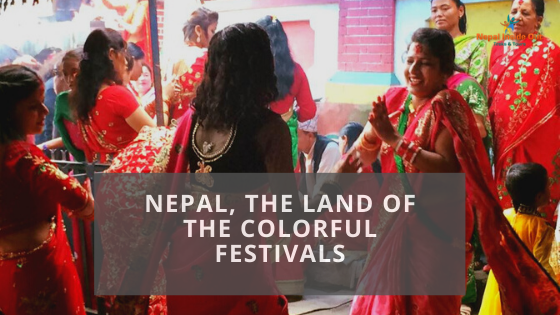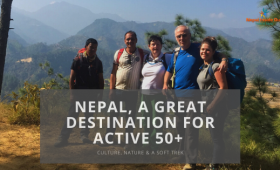Festivals, an important part of Nepalese culture
Nepal is a rather small country, yet it is home to a diverse mix of population groups, each with their own religion, culture and of course festivals! Each festival is unique and is experienced and performed in a different way. The festivals mainly provide social cohesion within the population group. It not only brings the people together, but also ensures that the people stay connected and that the centuries-old culture is passed on. The great thing about Nepal is that regardless of one’s religion or cultural background, everyone celebrates. This is a unique way to maintain social ties in Nepalese society and to reunite friends and families.
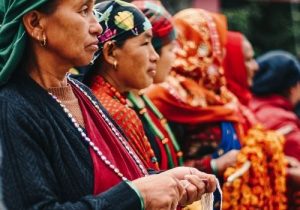 Most of the festivals are religious and connected to the most important gods and goddesses. The different Nepalese ethnicities have their own festival, which is celebrated within their own population group. There are also a number of festivals that are celebrated by everyone, regardless of their ethnic background. The most important of these Nepalese festivals are Dashain, Tihar, Maha Shivaratri, Teej and Holi. Even though Hinduism is the dominant religion, the Nepalese are generally tolerant and secular.
Most of the festivals are religious and connected to the most important gods and goddesses. The different Nepalese ethnicities have their own festival, which is celebrated within their own population group. There are also a number of festivals that are celebrated by everyone, regardless of their ethnic background. The most important of these Nepalese festivals are Dashain, Tihar, Maha Shivaratri, Teej and Holi. Even though Hinduism is the dominant religion, the Nepalese are generally tolerant and secular.
Culture and religion are important pillars for the unity and nationality of the nation of Nepal. So it is certainly worthwhile to see if you can combine your trip with experiencing a festival! This gives you a unique insight into the importance of festivals in Nepalese culture.
Below you find some of the dozens of festivals that are worth experiencing during a Nepal trip!
Festivals, celebrated all over the country
Dashain festival – the biggest festival in Nepal
Dashain is the largest and also the most important festival celebrated in Nepal. Also known as Navaratri and Durga Puja, this festival is a celebration of the good that overcame evil. The demon Mahisasura was defeated by the goddess Durga in an epic battle that lasted nine nights and ten days. During the festival that lasts ten days, the goddess Durga and her various forms are worshipped.
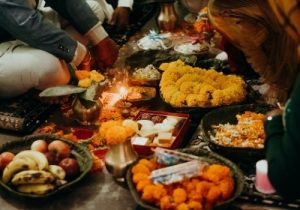 The first day of the festival starts with Ghatasthapana by planting Jamara (barley shoots) and ends with Mahanavami. The goddess Durga is worshipped throughout the festival of Dashain. Most households offer a sacrifice of male goats, ducks, chickens, eggs and coconuts to the goddess. Families and friends unite and celebrate together. Large bamboo swings are placed on the grounds for children and adults.
The first day of the festival starts with Ghatasthapana by planting Jamara (barley shoots) and ends with Mahanavami. The goddess Durga is worshipped throughout the festival of Dashain. Most households offer a sacrifice of male goats, ducks, chickens, eggs and coconuts to the goddess. Families and friends unite and celebrate together. Large bamboo swings are placed on the grounds for children and adults.
From the tenth day Vijaya Dasami begins, where family members receive a tika (a mixture of rice, red vermilion and yogurt) on their foreheads and a barley shoot from the hands of their elders as a symbol of protection and blessing. Relatives and friends from far and wide come together to receive Tika, followed by a feast that lasts until the next full moon.
The best location to experience this festival is in a village in the countryside. In this period everyone goes back to his or her native village and Kathmandu is rather quiet.
Where: throughout the country, but more visible in the countryside
When: October
Tihar – the festival of light
Tihar is the second most important festival after Dashain, which is mainly celebrated to honour Lakshmi, the goddess of wealth. The five-day festival is also called Yama Panchak, after Yama, the god of death, and the Underworld.
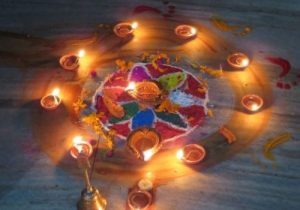 The first day is called Kag Tihar, and the crow is worshipped as the messenger of Yama. Dogs are worshipped on the second day or the Kukur Tihar. That day they honour this faithful four-legged friend for all his devotion and love. The dog is also seen as Yama’s guardian.
The first day is called Kag Tihar, and the crow is worshipped as the messenger of Yama. Dogs are worshipped on the second day or the Kukur Tihar. That day they honour this faithful four-legged friend for all his devotion and love. The dog is also seen as Yama’s guardian.
Tihar’s third day is Gai Tihar or Laksmi Puja. The cows are worshipped as the incarnation of the goddess Lakshmi. In the evening Lakshmi is worshipped and the house is lit with oil lamps, candles and colourful light bulbs. An extensive ceremony is performed to welcome and bless the goddess of wealth. In the evening Bhailo and Deusi are played, singing groups of women or men go around the houses of their friends, family and neighbours and singing traditional songs for a handout.
The oxes are honoured on the fourth day known as the Goru Puja or Gobardhan Puja. The steers occupy an important place in the countryside: all year round they work hard and pull the ploughs to the fields.
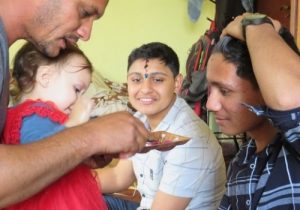
The last day of Tihar, Bhai Tika, celebrates eternal love and affection between brothers and sisters. Sisters put seven coloured Tika’s on their brothers’ foreheads and hang garlands of colourful flowers around their necks, wishing them prosperity, health and happiness. It is believed that the tradition of Bhai Tika began with Yama and his sister Yamuna.
Where: Everywhere in the country, especially in Kathmandu and Pokhara
When: October or November
Teej – the festival for women
This is quite unique, because there are not many countries that have a festival especially for women. This is originally a Hindu festival and is therefore mainly celebrated by Hindu women throughout the country. Although there are only non-Hindus who celebrate with their girlfriends or family.
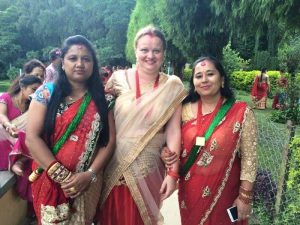
The Haritalika Teej festival lasts three days. Both married and unmarried women fast and worship the God Shiva. The married women pray for their husbands so that they will live long and healthy lives. Unmarried women wish for a perfect partner, someone like God Shiva. According to tradition, the goddess Parvati also had to fast to have Shiva as her husband. On the evening before the fast, the women eat a variety of fruit and candy to prepare for the fast.
During this festival married women visit their parental home. They dress in a beautiful red Sari with shiny glass beads and visit a Shiva temple to pray. The last day of the festival is called Rishi Panchami. On this day women take a bath in the nearby rivers and streams, brush their teeth with 108 pieces of medicinal plants and pay homage to Saptrarishi (seven saints). On this day the women also sacrifice to the Brahmanical priests. Everywhere women gather to sing and dance.
Where: everywhere in the country, especially near parks, squares and temples
When: end of August / beginning of September
Holi – the festival of colors
Phagu Purnima, also known as Holi, is one of the most colorful and playful festivals in Nepal. It is celebrated in the capital and the hilly area one day and the next day in the South of Nepal, the Terai.
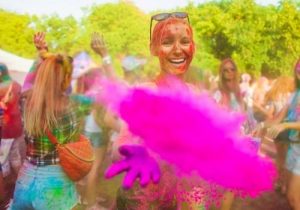 People celebrate this festival by smearing different kinds of vermilion and colored powder on the faces of their friends, relatives and relatives. Children also often throw colored water, water balloons and plastic bags filled with water on top of each other as part of the celebration. Meanwhile, people dance to traditional Nepalese music and go around the city to spread colours on each other.
People celebrate this festival by smearing different kinds of vermilion and colored powder on the faces of their friends, relatives and relatives. Children also often throw colored water, water balloons and plastic bags filled with water on top of each other as part of the celebration. Meanwhile, people dance to traditional Nepalese music and go around the city to spread colours on each other.
Together with the Nepalese, many foreigners also participate in the color festival, especially in Kathmandu and Pokhara.
Where: Everywhere, very visible in Kathmandu and Pokhara (in the most touristic parts), in the Terai one day later
When: in March
Maha Shivaratri – festival in honour of the God Shiva
Maha Shivaratri means the night of Lord Shiva. This is also an important Hindu festival. There are special ceremonies with sacrifices for the God Shiva, who is seen as a protector.
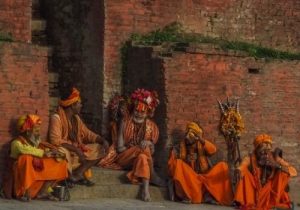 Female Hindus bathe early in the morning and fast all day. They visit the local Shiva temple and hold a vigil around bonfires in the streets all night to praise Shiva.
Female Hindus bathe early in the morning and fast all day. They visit the local Shiva temple and hold a vigil around bonfires in the streets all night to praise Shiva.
The full splendor of this festival can be seen in the Pashupatinath temple of Kathmandu, where thousands of Sadhus (ascetics) representing different orders and sects gather to celebrate Maha Shivaratri. These Sadhus are followers of Shiva and smoke marijuana and hashish. They also drink Bhang that day. This is a special brew made by mixing ground nuts, spices, herbs and extracts of the marijuana plant into milk.
Where: Pashupatinath, at Shiva temples, everywhere in the streets
When: February
Buddha Jayanti – the birthday of Lord Buddha
About 2600 years ago, the queen of Kapilvastu gave birth to a divine child, Siddhartha Gautam, in the sacred garden in Lumbini. Years later Prince Siddhartha left his house at night. He left his wife and son behind and went in search of peace and harmony in the world. After years of travelling, learning and meditation, Siddhartha reached enlightenment and became a Buddha.
Not only the Buddhists but also the Hindus worship Buddha as the ninth incarnation of Mr. Vishnu. Buddha’s birthday is celebrated by both Buddhists and Hindus. Several Buddhist sanctuaries and monasteries throughout Nepal enthusiastically celebrate that day.
In Lumbini, the birthplace of Buddha, there is a grand ceremony, with a procession. Special ceremonies are also organised in Kathmandu’s Swayambhunath, Boudhanath and other stupas.
Where: Lumbini, Boudhanath, Swayambunath, at all Buddhist monasteries and sanctuaries throughout the country
When: 7 May
Festivals – celebrated in a specific location in the Himalayas
In addition to the festivals mentioned above, which are celebrated throughout the country, there are also a number of festivals celebrated in a specific location in the mountains.
Mani Rimdu festival in Tengboche – Everest region
Mani Rimdu is a 19-day festival celebrated by Buddhists in the Himalayas to mark the foundation of Buddhism by Guru Rinpoche. On three different occasions big shows are performed in the monasteries of Tengboche, Thame and Chiwong. Large crowds of Buddhists from the area gather in these locations to celebrate.
The monks perform masked dances and tantrik rituals in the monasteries. Mani Rimdu takes place in October or November. The festival is celebrated after the full moon in autumn. In order to be able to calculate the date easily, this festival starts right after the full moon day of the Dashain festival. The festival can be easily combined with the Sherpa Culture trek, the Pikey Peak trek or the Gokyo trek!
Where: Tengboche
When: October / November
Tiji festival in Lo Manthang – Upper Mustang region
If you want to experience an ancient Buddhist tradition, then the Tiji festival is highly recommended. This annual festival lasts 3 days and takes place in April or May. Tibetan ritual dances are performed by the monks of the monastery in Lo Manthang. The festival celebrates the myth of the salvation of the Kingdom of Mustang.
“Tiji” is the abbreviation of the word “Tempa Chirim” which literally means “Prayer for World Peace”. The festival celebrates and commemorates the victory of Buddha’s incarnation Dorje Sonnu over the demon Man Tam Ru. This demon is an evil creature that eats people and causes disasters, such as storms and droughts.
On the first day, a dance is performed depicting the demon’s terrorization. On the second day of the festival the birth of Dorje Sonnu, the son of the demon, will be depicted in dances. On the third and final day the performance is about the attempt and success to bring the demon back to the world of Buddha. All these dances are organised by the Chöde monastery in Lo Manthang. The leader of the monastery is a Rinpoche and about 65 monks from the region live in this monastery. The monastery belongs to the Sakya movement within Buddhism.
Please note that to attend this festival you will need a special permit of 500 USD for the Upper Mustang region. This festival is best combined with a trekking in the beautiful Upper Mustang region.
Where: Lo Manthang
When: April / May
Yarthung festival in Manang – Annapurna region
In the local Yarthung festival the people of the Manang region celebrate this colourful and fascinating festival. Families from the surrounding villages gather to celebrate the return of the horses and cattle from the high pastures in the mountains. This Yarthung festival is one of the oldest mountain festivals.
During the festival, which lasts 4 days, the riders show their skills together with the strength of the horses. Traditionally, a competition is held between two villages: Manang and Braga. This horse race is followed by colourful ceremonies in the local temples. The Yartung festival is celebrated annually in the month of July. In the summer the landscape is lush green, the temperature is pleasant and the meadows are full of colourful flowers. This makes it a very important moment in the region.
Where: Manang
When: July
Festivals – celebrated in a specific community and/or location
Some of the best known city festivals only take place in a specific city. Of these, Bisket Jatra and Indra Jatra are undoubtedly the largest. The many different communities also have their own festivals, for example Gai Jatra is mainly celebrated by the Newar people and Sonam Lhosar by the Tamangs.
Bisket Jatra in Bhaktapur – the oldest festival in the Kathmandu Valley
The Bisket Jatra of Bhaktapur is probably the oldest festival in the Kathmandu Valley. The festival marks the end of the Nepalese calendar year and takes place on the last of the Nepalese year. By the way, did you know that Nepal has a different calendar? The New Year is therefore at a different time, namely around 15 April.
The highlights of this Bisket Jatra festival are the erection of a big totem pole, a ceremonial procession that goes through the streets and especially the worship of the different Gods and Goddesses. The most important moment of this festival is the erection and dismantling of a giant totem pole (Lingo). This 55 meter high totem pole will be pulled up by the crowds on the last day of the year in Bhaktapur in a huge ceremony. The totem pole stands for the god Indra, the king of heaven. A 35 metre long Dhvaja (flag) is also hung on the pole.
Where: Bhaktapur
When: mid-April
Indra Jatra – the most important festival in Kathmandu
The eight-day Indra Jatra festival is one of the most exciting festivals in the Newar community of the Kathmandu Valley. The Indra Jatra festival marks the beginning of the festival season in autumn.
The Jatra or procession is also linked here to the God Indra, the King of Heaven. It starts with the construction of a wooden totem pole made of pine for the Hanuman Dhoka Palace in Basantapur Square. To straighten out the totem, hundreds of spectators gather in the Palace Square and the surrounding temples. In an extended procession, the chariot of Kumari, the Living Goddess, is pulled through the main streets of Kathmandu. The goddesses Ganesh and Bhairav are also pulled around. Tens of thousands of people take part in this chariot procession that starts from the Kumari’s house.
At several places people perform masked traditional dances. It is a tradition for the President of the country, together with high-ranking members of the government and foreign diplomats, to visit Basantapur Square to attend the festival.
Where: Basantapur Durbar Square, Kathmandu
When: early September
Gai Jatra – the festival of the holy cow
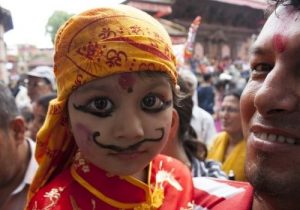 The Gai Jatra festival is a festival mainly celebrated by the large Newar community in the Kathmandu Valley and in part of Western Nepal. It commemorates the deceased family members. It is believed that cows bring the souls of the deceased to the Gate of Heaven.
The Gai Jatra festival is a festival mainly celebrated by the large Newar community in the Kathmandu Valley and in part of Western Nepal. It commemorates the deceased family members. It is believed that cows bring the souls of the deceased to the Gate of Heaven.
During the Gai Jatra festival processions are organized. Participants are disguised as cows and perform the traditional dance of Ghintang Gisi Twakka. The ancient tradition survived and the Newari people still observe Gai Jatra to this day to honor their deceased relatives.
Where: Cities with large Newari populations such as Patan, Bhaktapur, Kirtipur and parts of the West of Nepal
When: August
Sonam Lhosar – New year for the Tamang people
In addition to a Nepalese calendar, most population groups in Nepal also have their own annual calendar. This means that they celebrate their own New Year. The word Lhosar means New Year or the beginning of a new era.
Sonam Lhosar is the New Year’s Day of the largest minority group in Nepal, the Tamang. The Tamangs have their own culture and dialects that distinguish them from other ethnic groups. Literally Tamang means ‘horse traders’ and according to legend they come from Tibet. The largest Tamang community can be found both in the central highlands and around the Kathmandu Valley.
Tamangs divide their years into 12 cycles, each represented by a zodiac. When there was no Nepalese calendar, this system was also used to calculate someone’s age. Like other communities, the Tamangs celebrate their New Year’s Eve celebration exuberantly. The duration varies from place to place and can last from five to fifteen days.
The houses are cleaned and decorated to welcome the New Year. Stupas and monasteries are visited in traditional costumes. Buddhist monks perform masked dances and rituals. In this way they expel negative forces and bring prosperity to the families and the Tamang people. The stupas, monasteries and houses are decorated with colourful prayer flags and decorations to welcome peace and harmony.
Where: large squares in Kathmandu, near Buddhist sites, in Tamang villages and regions
When: end of January
Dates of the Nepalese festivals
The dates of the different festivals are different every year and depend on the phases of the Moon. That is why most festivals do not mention a specific date, but only a month or period. Please let us know if you are interested in visiting a festival during your Nepal trip and we will find out for you from which festival you can participate in the period you plan to travel.

